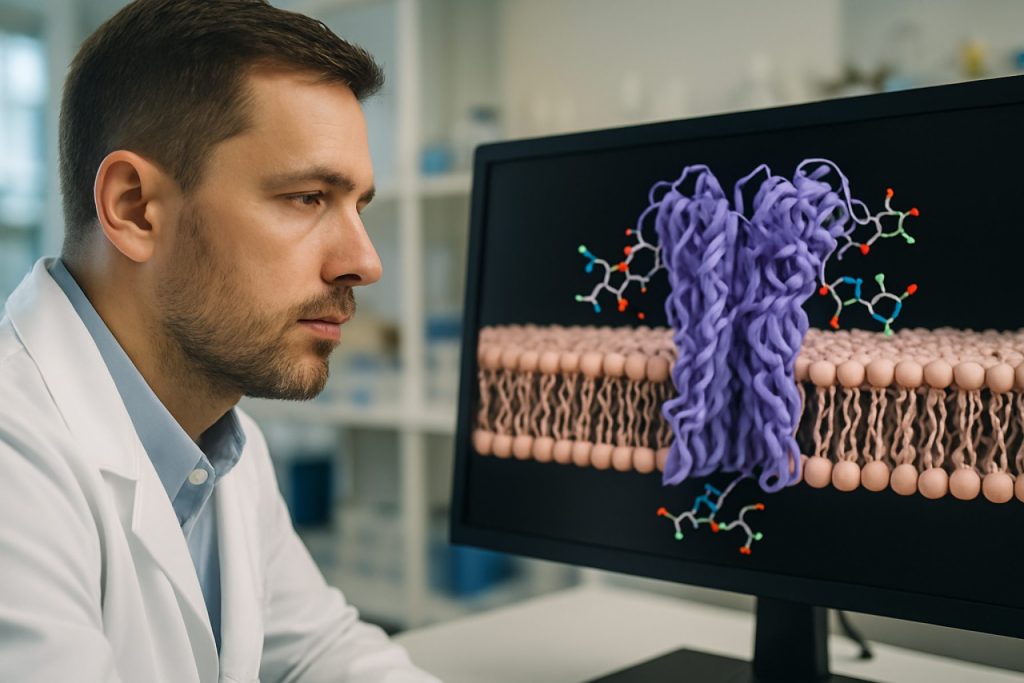
Unlocking the Power of Voltage-Gated Ion Channel Ligands: How These Molecular Gatekeepers Are Revolutionizing Drug Discovery and Neurological Therapies
- Introduction: What Are Voltage-Gated Ion Channel Ligands?
- Mechanisms of Action: How Ligands Modulate Ion Channel Function
- Therapeutic Applications: From Neurological Disorders to Cardiac Arrhythmias
- Recent Breakthroughs and Emerging Research
- Challenges in Ligand Design and Selectivity
- Future Directions: Next-Generation Ligands and Clinical Potential
- Conclusion: The Transformative Impact of Voltage-Gated Ion Channel Ligands
- Sources & References
Introduction: What Are Voltage-Gated Ion Channel Ligands?
Voltage-gated ion channel ligands are a diverse group of molecules that interact specifically with voltage-gated ion channels (VGICs), which are transmembrane proteins responsible for the rapid and selective flow of ions such as sodium, potassium, calcium, and chloride across cell membranes in response to changes in membrane potential. These ligands can act as agonists, antagonists, or modulators, influencing the opening, closing, or inactivation of the channels, thereby affecting cellular excitability and signaling. The physiological and pharmacological significance of VGIC ligands is profound, as they play critical roles in neuronal communication, muscle contraction, hormone secretion, and cardiac rhythm regulation.
VGIC ligands encompass a wide array of chemical entities, including endogenous peptides, small organic molecules, toxins from animals (such as cone snails, scorpions, and spiders), and synthetic drugs. Their mechanisms of action are equally varied, ranging from direct pore blockage to allosteric modulation of channel gating. The specificity and potency of many natural ligands have made them invaluable tools for dissecting channel function and as lead compounds in drug development. For example, certain anticonvulsants and antiarrhythmics exert their therapeutic effects by targeting voltage-gated sodium or potassium channels, while some analgesics modulate voltage-gated calcium channels to reduce pain transmission National Center for Biotechnology Information.
Given their central role in physiology and disease, voltage-gated ion channel ligands are a major focus of biomedical research, with ongoing efforts to discover novel ligands and optimize their therapeutic potential for conditions such as epilepsy, chronic pain, cardiac arrhythmias, and neurodegenerative disorders European Medicines Agency.
Mechanisms of Action: How Ligands Modulate Ion Channel Function
Voltage-gated ion channel ligands exert their effects by binding to specific sites on ion channels, thereby modulating their gating properties and ion conductance. These ligands can act as agonists, antagonists, or allosteric modulators, each influencing channel function through distinct mechanisms. Agonists typically stabilize the open state of the channel, enhancing ion flow, while antagonists block the channel pore or stabilize the closed or inactivated state, reducing ion permeability. Allosteric modulators bind to sites separate from the primary ion-conducting pore, inducing conformational changes that alter channel sensitivity to voltage or other ligands.
The interaction between ligands and voltage-gated ion channels often involves highly specific molecular recognition, with certain ligands targeting particular channel subtypes. For example, local anesthetics and antiarrhythmic drugs commonly bind within the inner pore of voltage-gated sodium channels, obstructing ion passage and stabilizing the inactivated state, which is crucial for their therapeutic effects in pain and cardiac arrhythmias National Center for Biotechnology Information. Peptide toxins from animal venoms, such as those from scorpions and cone snails, can bind to extracellular domains, altering channel gating or selectivity National Institutes of Health.
Additionally, some ligands exhibit state-dependent binding, preferentially interacting with channels in specific conformations (e.g., open, closed, or inactivated), which underlies their use-dependent or frequency-dependent pharmacological profiles. This property is particularly relevant for drugs targeting hyperactive or pathologically firing neurons, as seen in epilepsy or chronic pain syndromes U.S. Food and Drug Administration. Thus, the precise mechanism by which a ligand modulates voltage-gated ion channel function is determined by its binding site, channel state preference, and the resulting conformational changes in the channel protein.
Therapeutic Applications: From Neurological Disorders to Cardiac Arrhythmias
Voltage-gated ion channel ligands have emerged as pivotal agents in the treatment of a wide spectrum of diseases, particularly neurological disorders and cardiac arrhythmias. These ligands, which include both small molecules and biologics, modulate the activity of ion channels such as sodium, potassium, and calcium channels, thereby influencing cellular excitability and signaling. In neurology, voltage-gated sodium channel blockers like carbamazepine and lamotrigine are mainstays in the management of epilepsy, reducing neuronal hyperexcitability and seizure frequency. Similarly, calcium channel blockers such as gabapentin and pregabalin are widely used for neuropathic pain and certain forms of epilepsy, acting by dampening abnormal neuronal firing U.S. Food & Drug Administration.
In the realm of cardiology, voltage-gated ion channel ligands are essential for rhythm control. Class I and III antiarrhythmic drugs, such as lidocaine (a sodium channel blocker) and amiodarone (a potassium channel blocker), are used to treat life-threatening ventricular arrhythmias and atrial fibrillation by stabilizing cardiac action potentials and preventing aberrant electrical activity European Medicines Agency. Moreover, ongoing research is exploring selective ligands for specific channel subtypes, aiming to minimize side effects and improve therapeutic outcomes in conditions like chronic pain, migraine, and inherited arrhythmia syndromes National Institute of Neurological Disorders and Stroke.
The expanding repertoire of voltage-gated ion channel ligands underscores their therapeutic versatility and the promise of precision medicine approaches targeting channelopathies across multiple organ systems.
Recent Breakthroughs and Emerging Research
Recent years have witnessed significant breakthroughs in the discovery and characterization of voltage-gated ion channel ligands, driven by advances in structural biology, high-throughput screening, and computational modeling. The elucidation of high-resolution structures of voltage-gated sodium, potassium, and calcium channels has enabled rational drug design, allowing researchers to identify novel binding sites and develop ligands with improved specificity and efficacy. For instance, cryo-electron microscopy has provided detailed insights into channel conformational states, facilitating the design of state-dependent modulators that preferentially target pathological channel activity while sparing normal physiological function (Nature).
Emerging research has also focused on the development of peptide-based ligands derived from animal venoms, which often exhibit high selectivity for specific channel subtypes. These peptides serve as valuable pharmacological tools and potential therapeutic leads, particularly for pain, epilepsy, and cardiac arrhythmias (National Center for Biotechnology Information). Additionally, advances in computational chemistry and machine learning are accelerating the identification of small-molecule modulators by predicting ligand-channel interactions and optimizing pharmacokinetic properties (Cell Press).
Another promising area is the exploration of allosteric modulators, which bind to sites distinct from the channel pore and offer the potential for fine-tuned modulation with reduced side effects. Collectively, these breakthroughs are expanding the therapeutic landscape for voltage-gated ion channel ligands, with several candidates advancing into clinical trials for neurological, cardiovascular, and pain disorders.
Challenges in Ligand Design and Selectivity
Designing ligands for voltage-gated ion channels (VGICs) presents significant challenges, primarily due to the high degree of structural conservation among channel subtypes and the dynamic nature of their conformational states. Achieving subtype selectivity is particularly difficult because the pore-forming α-subunits of VGICs, such as those in sodium, potassium, and calcium channels, often share highly homologous amino acid sequences, especially within the transmembrane domains that form the ligand-binding sites. This similarity increases the risk of off-target effects, which can lead to adverse side effects or toxicity in clinical applications National Center for Biotechnology Information.
Another major challenge is the state-dependent accessibility of binding sites. Many ligands preferentially bind to specific channel conformations (e.g., open, closed, or inactivated states), which are transient and influenced by the physiological environment. This dynamic behavior complicates the prediction and optimization of ligand efficacy and selectivity Nature Reviews Drug Discovery. Additionally, the presence of auxiliary subunits and post-translational modifications can further modulate channel pharmacology, adding layers of complexity to rational ligand design.
Advances in high-resolution structural biology, such as cryo-electron microscopy, have begun to reveal subtle differences in channel architecture that can be exploited for selective ligand targeting. However, translating these insights into clinically useful compounds remains a formidable task, requiring iterative cycles of structure-based design, functional screening, and in vivo validation Cell Press.
Future Directions: Next-Generation Ligands and Clinical Potential
The future of voltage-gated ion channel ligands is poised for significant advancement, driven by innovations in molecular design, high-throughput screening, and precision medicine. Next-generation ligands are being engineered for enhanced selectivity, potency, and safety, addressing the limitations of current therapeutics that often suffer from off-target effects and narrow therapeutic windows. Structure-based drug design, leveraging high-resolution cryo-EM and X-ray crystallography data, enables the rational development of ligands that can discriminate between closely related ion channel subtypes, potentially reducing adverse effects and improving efficacy Nature Reviews Drug Discovery.
Emerging modalities include allosteric modulators, which bind to sites distinct from the channel pore, offering nuanced control over channel activity and the possibility of tissue- or state-dependent modulation. Peptidomimetics and biologics, inspired by natural toxins, are also under investigation for their ability to target ion channels with high specificity Neuron. Additionally, advances in computational modeling and machine learning are accelerating the identification and optimization of novel ligands, while phenotypic screening in patient-derived cells supports the development of personalized therapies.
Clinically, next-generation ligands hold promise for treating a range of conditions, including chronic pain, epilepsy, cardiac arrhythmias, and neurodegenerative diseases. Ongoing clinical trials are evaluating the safety and efficacy of these agents, with several candidates demonstrating encouraging results in early-phase studies U.S. National Library of Medicine. As our understanding of ion channelopathies deepens, the integration of genomics and pharmacology will further refine ligand development, paving the way for precision therapeutics tailored to individual patient profiles.
Conclusion: The Transformative Impact of Voltage-Gated Ion Channel Ligands
Voltage-gated ion channel ligands have emerged as transformative agents in both basic neuroscience research and clinical therapeutics. By selectively modulating the activity of ion channels, these ligands have enabled unprecedented insights into the mechanisms of neuronal excitability, synaptic transmission, and the pathophysiology of numerous neurological and cardiovascular disorders. Their specificity and potency have made them invaluable tools for dissecting the roles of individual channel subtypes, facilitating the development of targeted interventions for conditions such as epilepsy, chronic pain, arrhythmias, and certain psychiatric disorders (National Center for Biotechnology Information).
Clinically, the application of voltage-gated ion channel ligands has led to the approval of several first-in-class drugs, including anticonvulsants, antiarrhythmics, and analgesics, which have significantly improved patient outcomes. Moreover, ongoing advances in structural biology and high-throughput screening are accelerating the discovery of novel ligands with enhanced selectivity and safety profiles (U.S. Food and Drug Administration). The integration of computational modeling and precision medicine approaches promises to further refine ligand design, minimizing adverse effects while maximizing therapeutic efficacy.
In summary, voltage-gated ion channel ligands represent a cornerstone of modern pharmacology and neuroscience. Their continued development holds the potential to revolutionize the treatment of a wide array of diseases, underscoring their enduring impact on both scientific understanding and clinical practice (National Institute of Neurological Disorders and Stroke).
Sources & References
- National Center for Biotechnology Information
- European Medicines Agency
- Nature
- U.S. National Library of Medicine



